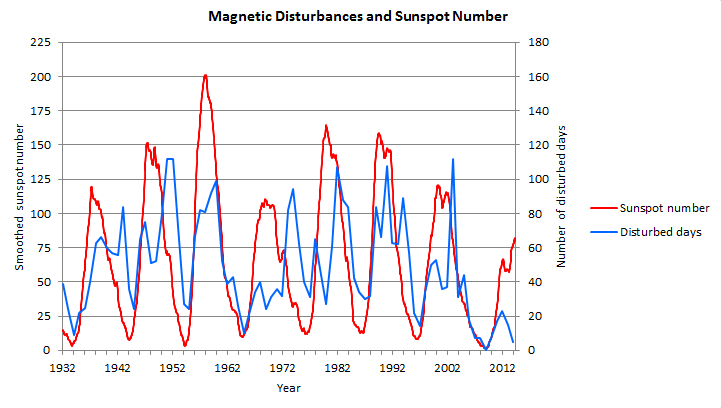The Occurrence of Geomagnetic Disturbances
As might be expected, geomagnetic disturbances are not equally likely at all phases of the solar cycle and for all different solar cycles. The Figure shows the solar cycles and the occurrence of geomagnetic disturbances since 1932. For the purposes of this graph, a disturbance has been defined as a day on which the Ap index equals, or exceeds, a value of 25 and the number of such days in each calendar year has been counted.
The occurrence of geomagnetic disturbances shows a trend generally similar to the solar cycle with periods of reduced frequency of disturbances near solar minimum. However, there appear to be two components which determine the occurrence of disturbances during the main part of the cycle. Firstly, there is a component which varies in phase with the solar cycle and seems to be related to flare and coronal mass ejection events. Secondly, there is a component which results in large peaks of disturbance in the declining phase of some, but not all, solar cycles. This component is related to coronal holes and produced large peaks of disturbance in 1950-53 (the declining phase of Cycle 18), in 1974-76 (Cycle 20) and in 1982-84 (Cycle 21) but no corresponding large peak in the declining phase of Cycle 19. The geomagnetic disturbances which make up this activity is distinctive in that they are recurrent disturbances (i.e. spaced at intervals of 27 days) reflecting the properties of the coronal holes from which they arise.
The recurrent disturbances in the declining phase have given rise to a successful technique for predicting the amplitude of the next solar cycle. It turns out that the size and strength of the declining phase burst of disturbances is related to the amplitude of the next solar cycle. Hence, a large solar cycle such as Cycle 19 was preceded by a burst of recurrent disturbances prior to the onset of the cycle (in this case in 1950-53). On the other hand, a relatively weak cycle such as Cycle 20 was preceded by a small burst of disturbances (around 1963 and hardly visible in the Figure).






